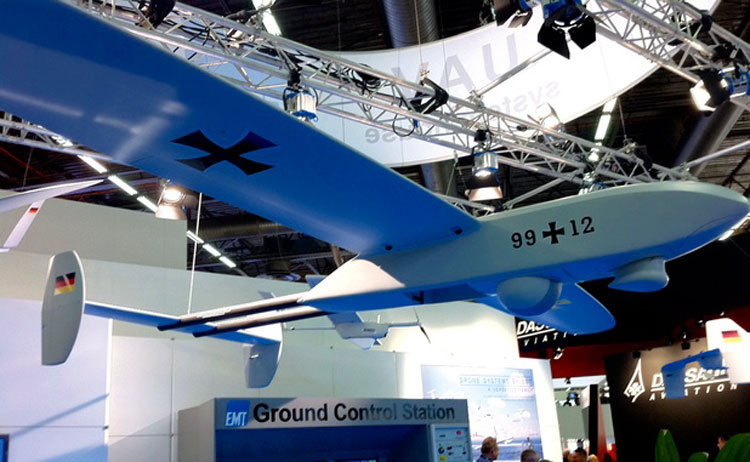European unmanned aircraft programs advance in stops and starts, but given current budget limitations any movement is welcome.
In Germany and France, there are now signs that long-expected unmanned aircraft modernization programs may be gaining traction, if only at an early stage. Both countries are mulling whether fixed-wing or helicopter-based systems are the way forward, or whether they should buy a mix of systems. Despite much discussion in Europe about cooperation on new procurements, at this point there is no indication that Berlin and Paris plan to work hand-in-hand.
Germany is starting to think about how to replace its KZO and Luna tactical UAVs now used in Afghanistan. The timeline is not set, but it has industry looking at options. German unmanned aircraft maker EMT is working on the Luna NG (next-generation) which is still in the development and concept phase. The exact configuration is still evolving and will largely depend on where the German military's requirement ends up.
The NG will feature greater payload capacity and endurance than the existing version. The payload is expected to be variable, between 15 kg (33 lb.) and 30 kg, depending on how users want to trade payload for endurance (the current Luna has a payload of around 5 kg). At 15 kg, EMT targets 14-hr. endurance. A demonstration flight of the Luna NG is likely before year-end, a company official says.
The Luna NG would be able to carry multiple payloads. Like Luna, it could act as a beyond line-of-sight relay for other Luna NGs, but do so even while carrying a surveillance sensor.
With uncertainty over whether Germany will also opt for a vertical-takeoff-and-landing system, EMT is keeping a foot in both camps and is finishing assembly of the 130-kg-class Museco helicopter unmanned aircraft. It is to be delivered soon to the German defense ministry's armaments agency, the BWB.
EADS also has its eye on the market and is about to take control of a UAV joint venture in Germany that combines Rheinmetall's programs, such as KZO, with its own, says Nicolas Chamussy, head of unmanned systems at Cassidian. The company is looking at a tactical system that could operate in more austere conditions than larger tactical unmanned aircraft, such as the Thales Watchkeeeper the U.K. is buying.

In France, the military has recently issued a request for information for its tactical unmanned aircraft. The goal is to define what a future requirement should look like, industry officials say. The army undertook a similar exercise several years ago, but never moved to procurement.
Sagem, a previous provider of that capability to the French army, is looking at the Patroller-S UAV as a candidate. The modular UAV can be fitted with pod-mounted payloads for flights lasting 20-30 hr. at a maximum altitude of 25,000 ft.
Sagem recently completed a series of 18 test flights of the system during flight trials conducted in March. The UAV carried a new version of the Sagem Euroflir 350 gyrostabilized imaging pod, including a high-definition television channel, third-generation high-definition infrared channel and a laser rangefinder. Patroller also flew a ship automatic identification system receiver used for real-time monitoring of cooperative maritime traffic as well as a distress-beacon detector.
Patrick Durieux, vice president of sales for Sagem UAVs and aerosurveillance, said the tests proved Patroller's ability to fuse data from different sensors and transmit it to a command and control center for coastal surveillance. These tests also showed the ease with which new payloads can be integrated into the 1-ton-class drone's mission system, and the complementary capabilities of the optronic and electronic sensors in tactical situations. Durieux estimates Sagem can deliver Patroller S for €25-30 million ($32-$40 million) per three-aircraft system.
EADS has focused more on the potential interest of the French army in a helicopter UAV. There is also interest in such a system from the French navy, with political pressure, at times, for a combined purchase. Flight trials have confirmed the Tanan system should meet an 8-10-hr. endurance target set for the 300-kg vehicle, Chamussy says. Specific fuel consumption of the diesel engine is surpassing expectations, he notes. EADS is now ensuring that production can also be industrialized.
Larger questions in France hang over the way forward in the medium-altitude, long-endurance UAV sector.
During a Franco-British summit held in February, U.K. Prime Minister David Cameron and then-French President Nicolas Sarkozy agreed to forge ahead with joint development of a medium-altitude, long-endurance (MALE) drone by 2020.
While the accord singled out Paris-based Dassault Aviation and Britain's BAE Systems to study design concepts, the new government of President Francois Hollande is reviewing France's broader UAV strategy. By July 14 French Defense Minister Jean-Yves Le Drian has vowed to provide more clarity, including whether France will proceed with an interim purchase of a MALE system planned by the previous administration. The French air force would like to field a system with weapons-delivery capability.
Dassault has been promoting the purchase of Israel Aerospace Industries' Heron-TP, while EADS is pushing continuation of the current Harphang—a version of the basic Heron—rather than making an interim purchase, noting that the government could decide whether it would be largely an off-the-shelf system or a system more tailored to French needs.
At this point any decision would be helpful, notes Eric Trappier, executive vice president-international at Dassault. “At least it would give us some clarity,” he says.
Quelle;AviationWeek
6380 Views
